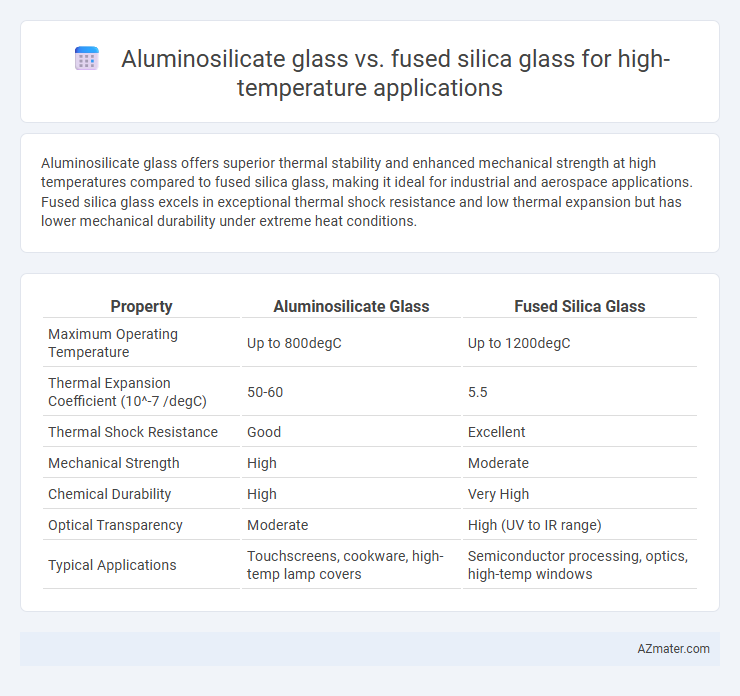Aluminosilicate glass offers superior thermal stability and enhanced mechanical strength at high temperatures compared to fused silica glass, making it ideal for industrial and aerospace applications. Fused silica glass excels in exceptional thermal shock resistance and low thermal expansion but has lower mechanical durability under extreme heat conditions.
Table of Comparison
| Property | Aluminosilicate Glass | Fused Silica Glass |
|---|---|---|
| Maximum Operating Temperature | Up to 800degC | Up to 1200degC |
| Thermal Expansion Coefficient (10^-7 /degC) | 50-60 | 5.5 |
| Thermal Shock Resistance | Good | Excellent |
| Mechanical Strength | High | Moderate |
| Chemical Durability | High | Very High |
| Optical Transparency | Moderate | High (UV to IR range) |
| Typical Applications | Touchscreens, cookware, high-temp lamp covers | Semiconductor processing, optics, high-temp windows |
Introduction to High-Temperature Glass Applications
Aluminosilicate glass and fused silica glass are essential materials for high-temperature applications due to their exceptional thermal stability and resistance to thermal shock. Aluminosilicate glass offers enhanced mechanical strength and chemical durability, making it suitable for automotive and aerospace components exposed to temperatures up to 1000degC. Fused silica glass provides superior purity and low thermal expansion, allowing it to maintain structural integrity in processes exceeding 1200degC, commonly used in semiconductor manufacturing and high-precision optical systems.
Overview of Aluminosilicate Glass
Aluminosilicate glass exhibits excellent thermal resistance and mechanical strength due to its high alumina content, making it suitable for high-temperature applications such as furnace windows and protective covers in electronics. It offers superior durability against thermal shock and chemical corrosion compared to many standard glasses, with a typical softening point around 1,000degC. This type of glass balances affordability and performance, providing a cost-effective alternative to fused silica glass, which has even higher thermal stability but at increased manufacturing costs.
Understanding Fused Silica Glass
Fused silica glass, composed almost entirely of silicon dioxide (SiO2), offers exceptional thermal stability and a low coefficient of thermal expansion, making it ideal for high-temperature applications exceeding 1000degC. Its purity and amorphous structure provide superior resistance to thermal shock and chemical corrosion compared to aluminosilicate glass, which contains aluminum oxide and exhibits higher expansion rates. Fused silica's outstanding mechanical strength and optical clarity under extreme heat conditions are critical for semiconductor manufacturing, aerospace, and high-intensity lighting technologies.
Thermal Resistance: Aluminosilicate vs Fused Silica
Aluminosilicate glass exhibits high thermal resistance with a maximum use temperature around 400-500degC, benefiting from its alumina content that enhances mechanical strength and thermal stability. Fused silica glass outperforms with an extremely high softening point above 1600degC and a low coefficient of thermal expansion, making it ideal for ultra-high temperature applications and rapid thermal cycling. For applications demanding superior thermal shock resistance and minimal deformation at elevated temperatures, fused silica is the preferred choice compared to aluminosilicate glass.
Mechanical Strength Comparison
Aluminosilicate glass exhibits superior mechanical strength and higher resistance to thermal shock compared to fused silica glass, making it ideal for high-temperature applications that require durability and impact resistance. Fused silica glass offers exceptional thermal stability and low thermal expansion but generally has lower mechanical strength under stress. For environments demanding both high thermal endurance and robust mechanical performance, aluminosilicate glass provides a more reliable solution than fused silica.
Chemical Durability at Elevated Temperatures
Aluminosilicate glass exhibits superior chemical durability at elevated temperatures compared to fused silica glass, maintaining resistance to alkalis, acids, and stress corrosion in harsh environments. Fused silica glass, despite its high purity and thermal stability, can be more susceptible to chemical attack and surface degradation when exposed to aggressive chemicals at high temperatures. These differences make aluminosilicate glass the preferred choice for applications demanding long-term chemical resistance in high-temperature settings, such as in industrial furnace components and chemical reactors.
Optical Properties in High-Heat Environments
Aluminosilicate glass exhibits superior mechanical strength and thermal shock resistance compared to fused silica glass, making it highly effective in high-temperature environments while maintaining good optical clarity and UV transmission. Fused silica glass, characterized by its ultra-low thermal expansion and exceptional optical transparency across a broad wavelength range, excels in maintaining optical stability under extreme heat but has lower mechanical durability than aluminosilicate variants. Both materials offer distinct advantages in optical applications involving high heat, with aluminosilicate preferred for robust structural performance and fused silica chosen for precision optical clarity and thermal stability.
Cost and Availability for Industrial Use
Aluminosilicate glass offers a cost-effective alternative to fused silica glass for high-temperature industrial applications due to its lower raw material expenses and simpler manufacturing processes. Fused silica glass, while outperforming aluminosilicate in thermal stability and chemical resistance, remains significantly more expensive and less readily available in large volumes. Industrial sectors seeking scalable solutions often favor aluminosilicate glass for its balance of performance, affordability, and widespread availability.
Typical Applications: Selecting the Right Glass
Aluminosilicate glass is preferred for high-temperature applications requiring excellent mechanical strength and thermal shock resistance, commonly used in smartphone screens, cooktops, and chemical processing ports. Fused silica glass excels in environments demanding superior thermal stability and low thermal expansion, making it ideal for semiconductor manufacturing equipment, infrared optics, and high-precision laboratory instruments. Choosing between these glasses depends on application-specific requirements such as temperature tolerance, thermal shock resistance, and optical clarity.
Conclusion: Choosing Between Aluminosilicate and Fused Silica
Aluminosilicate glass offers superior thermal shock resistance and durability for high-temperature applications, making it ideal for environments with rapid temperature fluctuations. Fused silica glass provides exceptional thermal stability and a low coefficient of thermal expansion, suitable for precision applications requiring minimal dimensional changes under heat. Selecting between aluminosilicate and fused silica depends on whether thermal shock resistance or dimensional stability is the primary requirement.

Infographic: Aluminosilicate glass vs Fused silica glass for High-temperature application
 azmater.com
azmater.com